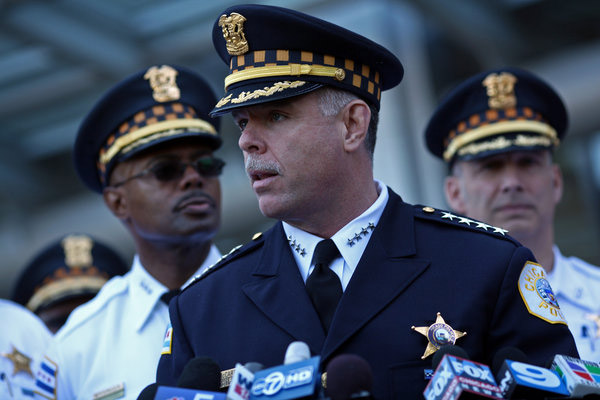
One of the controversies surrounding murder rates and the CPD in Chicago—not unique to Garry McCarthy's tenure—has been the use and disbanding of the city's specialized gang units over the past decade. When Noah Isakson profiled McCarthy for Chicago last year, he detailed the city's on-again, off-again implementation of the strategy:
One thing that McCarthy can’t do, however, is rely on units that specialize in fighting gangs—the teams that Hillard began disbanding as interim superintendent. McCarthy hasn’t moved to reinstate them, arguing that the officers’ expertise is better used in the districts. That’s one reason his gang strategy has failed to rouse support among the rank and file, whose job it is to proactively police the beats in the way their boss demands.
Police chiefs dating back to Phil Cline, who served from 2003 to 2007, relied on such specialized units. Under Cline and, later, Jody Weis, the units’ officers were chosen from among the department’s best and received special training. The work was dangerous and extremely stressful. “The beat officer is the backbone of the department,” says a former high-ranking police official. “Nobody is disagreeing with that. But a backbone needs to be supported by muscle. Those guys were the muscle."
If you want to get deep in the weeds, Todd Lighty and Steve Mills wrote about Hillard's decision in 2000—how they came about, what they did, why Hillard broke them up:
The move comes as a former gang leader connected to the federal investigation pleaded guilty on Tuesday in Cook County Circuit Court to the 1995 murder of a rival gang member. According to court documents, Nelson Padilla was able to elude authorities for years, allegedly with the aid of a veteran gang crimes officer.
The dismantling of the gang crimes unit also appears to signal a departure from the department's long-standing mission of targeting the upper ranks of street gangs by building complex conspiracy cases, a policy ushered in by Matt Rodriguez shortly after he became superintendent in 1992.
But then they came back. And went away. And came back again, and went away. Here's Isackson again:
For some communities, aggressive cops, known as “jump out boys,” represented the worst of the department. Revelations in 2006 that some officers robbed and kidnapped residents, and the accusations a year later that one officer plotted to murder another, bolstered that point of view.
McCarthy believes that specialization is the enemy of community policing—an idea that took root long before he came to Chicago. “With specialization, those guys have zero connection to the community,” he says. “They offend a lot of people because not everybody is a perp.”
Even so, it’s hard to argue with the effectiveness of specialized units. Consider what happened when Cline began using them to target gangs, guns, and drugs in certain neighborhoods on the South and West Sides. Chicago went from being the murder capital of the nation in 2003, with 601 people killed, to 453 the next year (see "Murder Capital of America?"). That was the first time since the 1960s that fewer than 500 murders had been recorded.
Homicides remained under the 500 mark until 2008. The previous fall, in the wake of ongoing scandal involving the rogue officers, Dana Starks, the interim superintendent between Cline and Weis, shelved the specialized units. Homicides began to rise. After Weis took the job, he convinced Mayor Daley in September 2008 to reinstate the units, promising that, as chief, he’d implement better training and more accountability.
According to Weis, the city’s sub-500 murder totals in 2009, 2010, and 2011 were a direct result of that decision. “Sometimes the answer is staring you right in the face,” he says.
So McCarthy's actually in a similar fix as his predecessors. The gang-specialist units, if history is any indication, don't come without risk to the CPD's reputation in the city and in communities. But the numbers (which are always tricky) suggest they work, at least in the short term. There are obviously many, many other factors, as UIC's John Hagedorn argued to Isakson, but the CPD is limited in what it can do; it's not an economic or public health agency. So an ongoing question has been how much rope McCarthy has on his approach.
Now WBEZ's Rob Wildeboer reports that the CPD is adding manpower to its compromise between the old gang units and McCarthy's embrace of community based policing:
Of the 200 officers being reassigned, Superintendent McCarthy says 60 will be placed in “saturation units,” which are similar to tactical units disbanded when Emanuel first took office. Those units go to crime hotspots but there’s an interesting backstory here.
[snip]
Police Supt. Garry McCarthy says the 60 officers will be added to about 200 other officers already in the saturation units. McCarthy says the units are different than the disbanded mobile strike force because the strike force moved citywide and the saturation units divvied up the city into three areas and they stay in their respective areas.
It's somewhere in between the old and new strategies: they're specialized units, but with more geographic focus. They're not uncontroversial, though; in July, Anthony Beale and Willie Cochran called for the old strike force.
Photograph: Chicago Tribune


